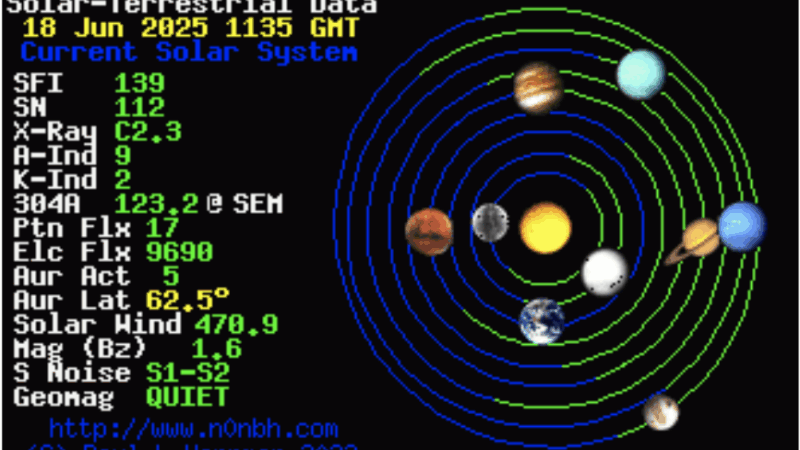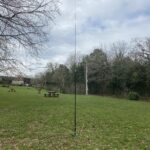How to read solar data for radio propagation [English version]

[ Este artículo está también disponible en Español ]
When you look at a solar-terrestrial report, you’ll likely come across various key values like the A-Index and K-Index, among others. These numbers help us understand whether the Earth’s magnetic field is calm or being affected by solar storms.
Quick summary for people in a hurry 🙂
- If you see high values in SFI, SN, and 304A, and low values in A, K, Bz, and Solar Wind, it’s a great day for operating on HF!
- On the other hand, if there are solar storms, high solar wind speeds, or M/X-class flares, propagation may become difficult.
Full Interpretation of each solar report value
K-Index
Measures rapid changes in Earth’s magnetic field
- Range: 0 to 9
- Low K (0–2): Very quiet geomagnetic field. Best time for HF operation, especially on high bands like 15 m, 12 m, and 10 m. Signals are stable and conditions are ideal.
- Moderate K (3–4): Slight disturbances, but still good propagation. Some noise or fading may occur.
- High K (5+): Geomagnetic storm. May cause temporary blackouts, lots of noise, and erratic propagation. High bands suffer more, but low bands (80 m, 40 m) may still work fine.
A-Index
Represents overall magnetic field stability over the past 24 hours
- Scale: 0 to 400
- Low A (0–7): Stable magnetic field, usually aligned with excellent propagation.
- Medium A (8–15): Active but still usable conditions. A good time to observe how bands behave.
- High A (16+): Indicates major storms or unstable conditions. Propagation becomes unpredictable.
SFI (Solar Flux Index)
Measures solar radiation at a specific frequency
- Above 100: Good conditions on high bands (20 m, 17 m, 15 m, 12 m, 10 m)
- Below 70: High bands likely closed or weak
→ Higher is better for DX on high bands
SN (Sunspot Number)
Visible sunspot count. Sunspots help ionize the atmosphere, improving propagation
- Above 50: Very good signal for HF propagation
- Low or 0: Likely poor propagation
→ More sunspots = better conditions
X-Ray (Solar Flares)
Indicates solar flare strength
- Class levels: A, B, C, M, X (from weakest to strongest)
- C-Class: Moderate flare
- M or X-Class: Can cause HF blackouts on Earth’s sunlit side
→ Watch out for M or X: risk of temporary HF shutdowns
304A (304 Angstrom Flux)
Measures extreme ultraviolet radiation affecting the ionosphere
- Above 100: Good ionization, great for long-distance (DX) propagation
→ High value = excellent conditions for skip propagation
Proton Flux (Ptn Flx)
Number of protons arriving from the sun
- High levels signal solar storms that can interfere with HF and damage satellites
→ If high, propagation may become erratic
Electron Flux (Elc Flx)
Measures energetic electrons in the magnetosphere
- Moderate-high: Helps high-band propagation
- Too high: Can cause noise or signal absorption
→ Good for propagation if it doesn’t spike too much
Aurora
Measures auroral activity
- Below 5: Normal conditions
- Above 5: Active auroras can negatively affect HF, especially at high latitudes
→ More aurora = worse HF propagation
Bz (Interplanetary Magnetic Field Component)
Shows how the solar magnetic field is interacting with Earth’s
- Negative (–): Can allow solar particles in, triggering auroras or disruptions
- Near 0 or positive (+): Calm conditions
→ Strongly negative Bz = potential geomagnetic storm
Solar Wind
Measures the speed of solar wind impacting Earth
- Below 400 km/s: Calm
- 400–600 km/s: Normal but a bit unsettled
- Above 600 km/s: Potential geomagnetic storm
→ Faster wind = more chance of instability
GeoMag Field
Overall state of Earth’s magnetic field
Can be labeled as: Quiet, Unsettled, Active, Storm, etc.
→ Quiet = ideal radio conditions
Sig Noise Level (Atmospheric Noise)
Baseline noise in S-units visible on your receiver
- S1–S2: Almost no noise, perfect conditions
- S5 or more: Lots of noise, harder to hear weak signals
→ Lower is better for reception





Comments are closed.